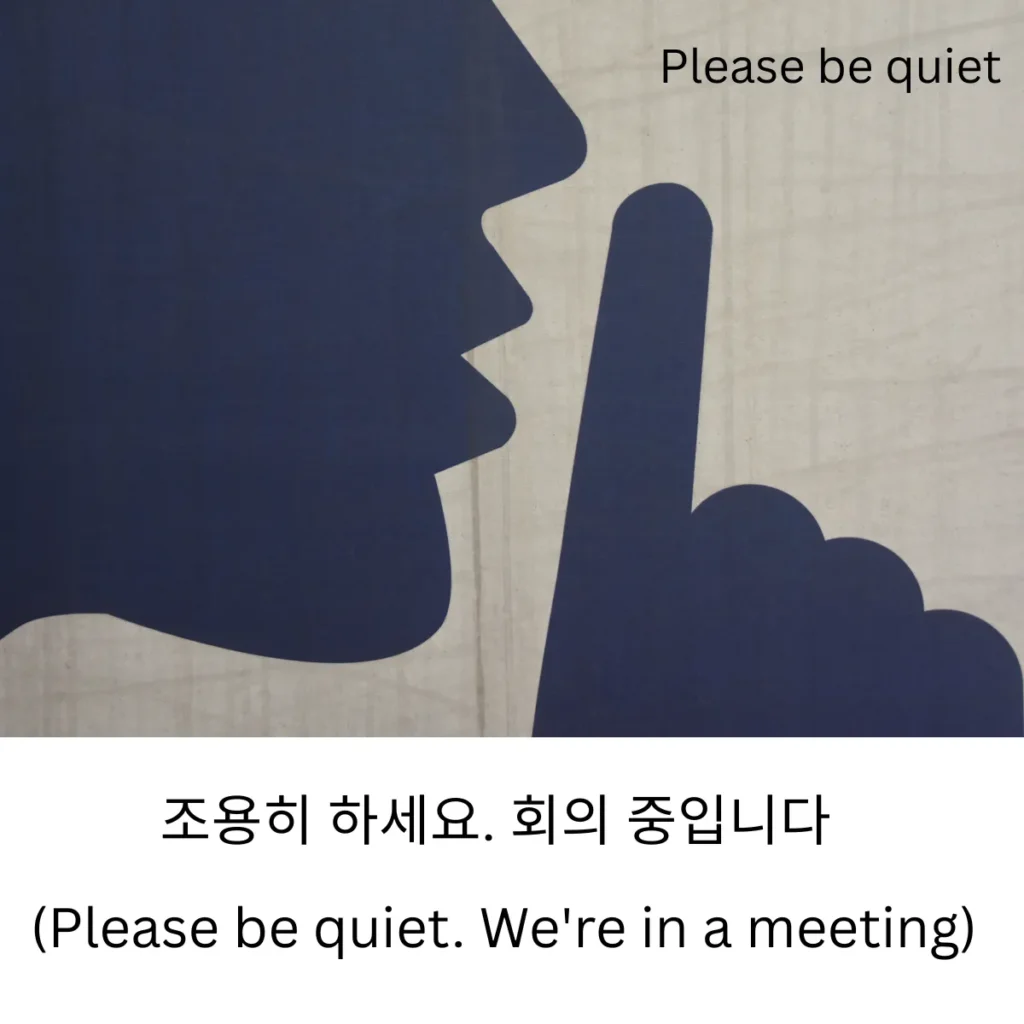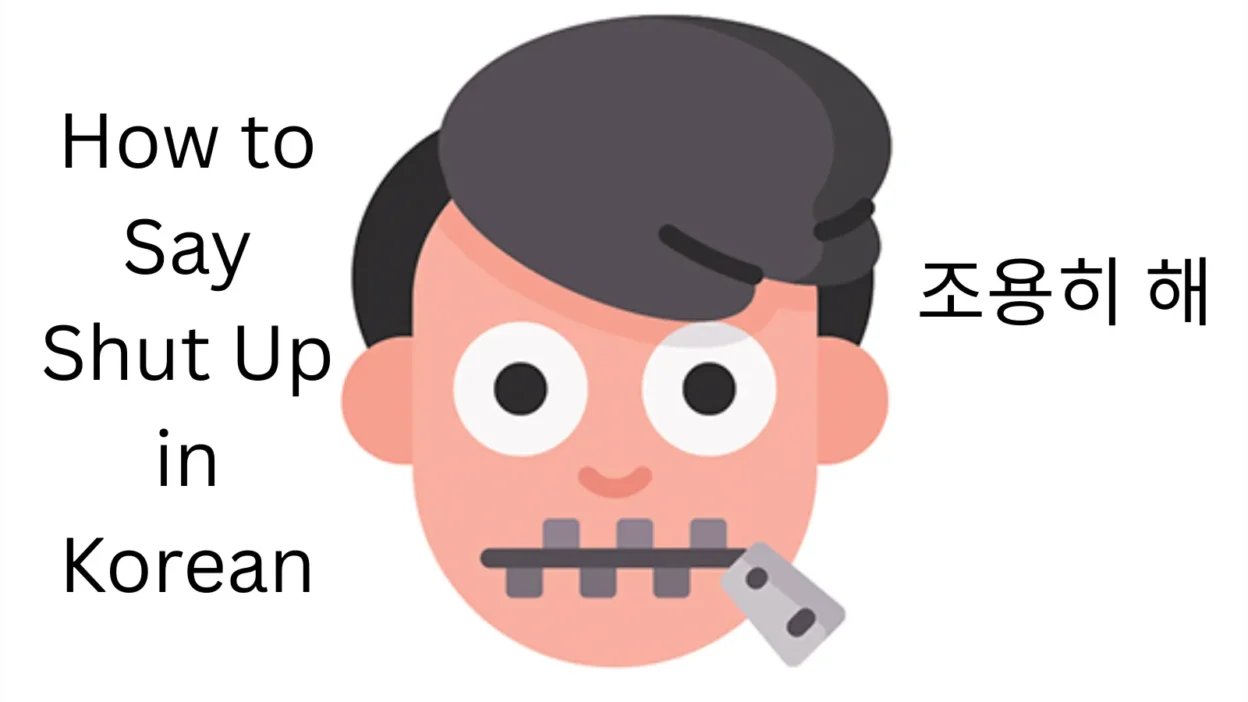How to Say Shut Up in Korean is something you might want to learn for fun, self-defense, or understanding Korean dramas and pop culture. While it’s not the most polite phrase, it can be useful to recognize or use in casual or emotional situations.
In this guide, we’ll explain how to say shut up in Korean in different tones—from playful to serious—along with when (and when not) to use it.
Learning how to say shut up in Korean can help you understand real-life conversations, especially in informal or dramatic contexts. It’s important to know the difference between rude, joking, and serious versions. By mastering how to say shut up in Korean, you’ll improve both your listening and cultural awareness.
Shut up in Korean:
15 ways to say shut up in Korean, from casual and playful to serious and even rude—with examples and background info to help you use each one naturally.
1. 조용히 해 (joyonghi hae) – Be quiet
Origin/Context:
This is the most polite and common way to ask someone to be quiet. “조용히” means “quietly,” and “해” is the casual form of “do.”
Dialogue:
👤 User A: 조용히 해, 수업 중이야.
👤 User B: 아, 미안해.
(Be quiet, we’re in class. — Oh, sorry.)
Use: Casual and neutral; good for friends or peers.
2. 조용히 하세요 (joyonghi haseyo) – Please be quiet (formal)

Origin/Context:
This is the formal version used with strangers, elders, or in public announcements.
Dialogue:
👤 User A: 조용히 하세요. 회의 중입니다.
👤 User B: 알겠습니다.
(Please be quiet. We’re in a meeting. — Understood.)
Use: Formal settings; polite yet firm.
3. 입 닥쳐 (ip dakchyeo) – Shut your mouth
Origin/Context:
Very rude and direct. “입” means mouth, and “닥쳐” is the imperative of “닥치다” (to shut up).
Dialogue:
👤 User A: 그만 좀 떠들어! 입 닥쳐!
👤 User B: 뭐라고? 너 지금 나한테 그랬어?
(Stop talking already! Shut your mouth! — What? Did you just say that to me?)
Use: Strong and offensive; avoid unless extremely angry or in dramatic fiction.
4. 닥쳐 (dakchyeo) – Shut up

Origin/Context:
The plain imperative form of the verb “닥치다.” It’s blunt and used in high-emotion situations.
Dialogue:
👤 User A: 닥쳐! 더 이상 못 참겠어!
👤 User B: …알았어.
(Shut up! I can’t take it anymore! — …Okay.)
Use: Very strong and rude; not recommended unless for dramatic effect.
5. 쉿! (swit) – Shh!
Origin/Context:
Onomatopoeic, universal sound used to hush someone. Same as “shhh” in English.
Dialogue:
👤 User A: 야, 너 어제…
👤 User B: 쉿! 선생님 오신다.
(Hey, yesterday you— — Shh! The teacher’s coming.)
Use: Quick and non-verbal; used to hush discreetly.
6. 좀 조용히 해 (jom joyonghi hae) – Please be quiet (softer)
Origin/Context:
Adding “좀” (a bit/please) softens the command. Polite but firm.
Dialogue:
👤 User A: 좀 조용히 해 줄래? 머리 아파.
👤 User B: 미안, 알았어.
(Can you be a bit quiet? I have a headache. — Sorry, got it.)
Use: Used among friends or in situations where you want to be respectful but clear.
7. 그만 좀 해 (geuman jom hae) – Stop it already
Origin/Context:
“그만” = stop; commonly used when someone is being annoying or too loud.
Dialogue:
👤 User A: 나 오늘 진짜 웃긴 얘기…
👤 User B: 그만 좀 해! 너무 시끄러워!
(I’ve got a really funny story— — Stop it already! You’re too loud!)
Use: Frustrated tone; commonly used with siblings, friends.
8. 입 다물어 (ip damureo) – Shut your mouth (literally: close your mouth)

Origin/Context:
Similar to “입 닥쳐” but slightly less aggressive.
Dialogue:
👤 User A: 네가 뭘 안다고 그래?
👤 User B: 입 다물어!
(What do you even know? — Shut your mouth!)
Use: Still rude, but less harsh than “닥쳐.”
9. 좀 가만히 있어 (jom gamanhi isseo) – Stay still / be quiet
Origin/Context:
A gentle way to tell someone to stay calm or quiet. “가만히” implies stillness or silence.
Dialogue:
👤 User A: 왜 이렇게 움직여?
👤 User B: 좀 가만히 있어!
(Why are you moving so much? — Just stay still, will you!)
Use: Used with kids, or someone who’s being fidgety or disruptive.
10. 잠깐만 조용히 해 (jamkkanman joyonghi hae) – Just be quiet for a moment
Origin/Context:
Polite and time-limited request; commonly used when needing silence briefly.
Dialogue:
👤 User A: 근데 말이야…
👤 User B: 잠깐만 조용히 해. 이거 들어야 돼.
(So the thing is… — Just be quiet for a second. I need to hear this.)
Use: Calm, respectful.
11. 좀 입 다물어줄래? (jom ip damureojullaeyo?) – Can you shut your mouth, please?
Origin/Context:
Adding “줄래” makes even harsh commands sound more polite or sarcastic.
Dialogue:
👤 User A: 너 또 시작이네.
👤 User B: 좀 입 다물어줄래?
(You’re at it again, huh? — Could you shut up, please?)
Use: Polite but biting; often sarcastic.
12. 그만 떠들어 (geuman tteodeureo) – Stop chattering

Origin/Context:
“떠들다” means to chatter or be noisy.
Dialogue:
👤 User A: 야, 어제 밤에—
👤 User B: 그만 떠들어. 집중 안 돼.
(Hey, last night I— — Stop talking. I can’t focus.)
Use: Common in classrooms or study environments.
13. 입 좀 닥쳐 (ip jom dakchyeo) – Would you shut up already?
Origin/Context:
Combines extreme rudeness with a sarcastic tone. Often heard in dramas or arguments.
Dialogue:
👤 User A: 네 말이 다 맞다는 듯이 말하지 마.
👤 User B: 입 좀 닥쳐!
(Don’t talk like you’re always right. — Just shut up already!)
Use: Strong, sarcastic; use cautiously.
14. 그 입 다물어 (geu ip damureo) – Close that mouth of yours
Origin/Context:
This version adds “그” (that), making it feel more personal and scolding.
Dialogue:
👤 User A: 내가 뭘 했다고?
👤 User B: 그 입 다물어.
(What did I even do? — Close that mouth.)
Use: Serious tone; often in parental scolding or TV scenes.
15. 조용조용~ (joyong joyong~) – Quiet quiet~
Origin/Context:
Playful and childlike. Often used by kindergarten teachers or to calm down a crowd with a smile.
Dialogue:
👤 Teacher: 얘들아~ 조용조용~
👤 Kids: 네에~
(Kids~ Quiet quiet~ — Okaaay~)
Use: Gentle, sweet, non-threatening.
Conclusion:
🤫 Now that you know how to say shut up in Korean, you can better understand its usage in everyday conversations, K-dramas, or even playful exchanges with friends.
Just remember, context and tone matter a lot—what may sound funny in one setting can be offensive in another.
Keep practicing how to say shut up in Korean to recognize its variations and respond appropriately. With cultural understanding, you’ll be able to use or interpret the phrase with confidence and respect.
Also, knowing when not to use it is just as important. Always be mindful and respectful while learning how to say shut up in Korean.



